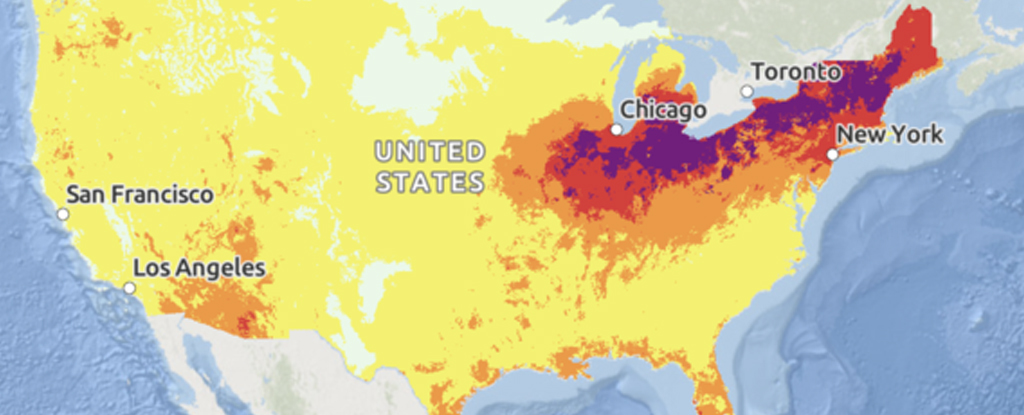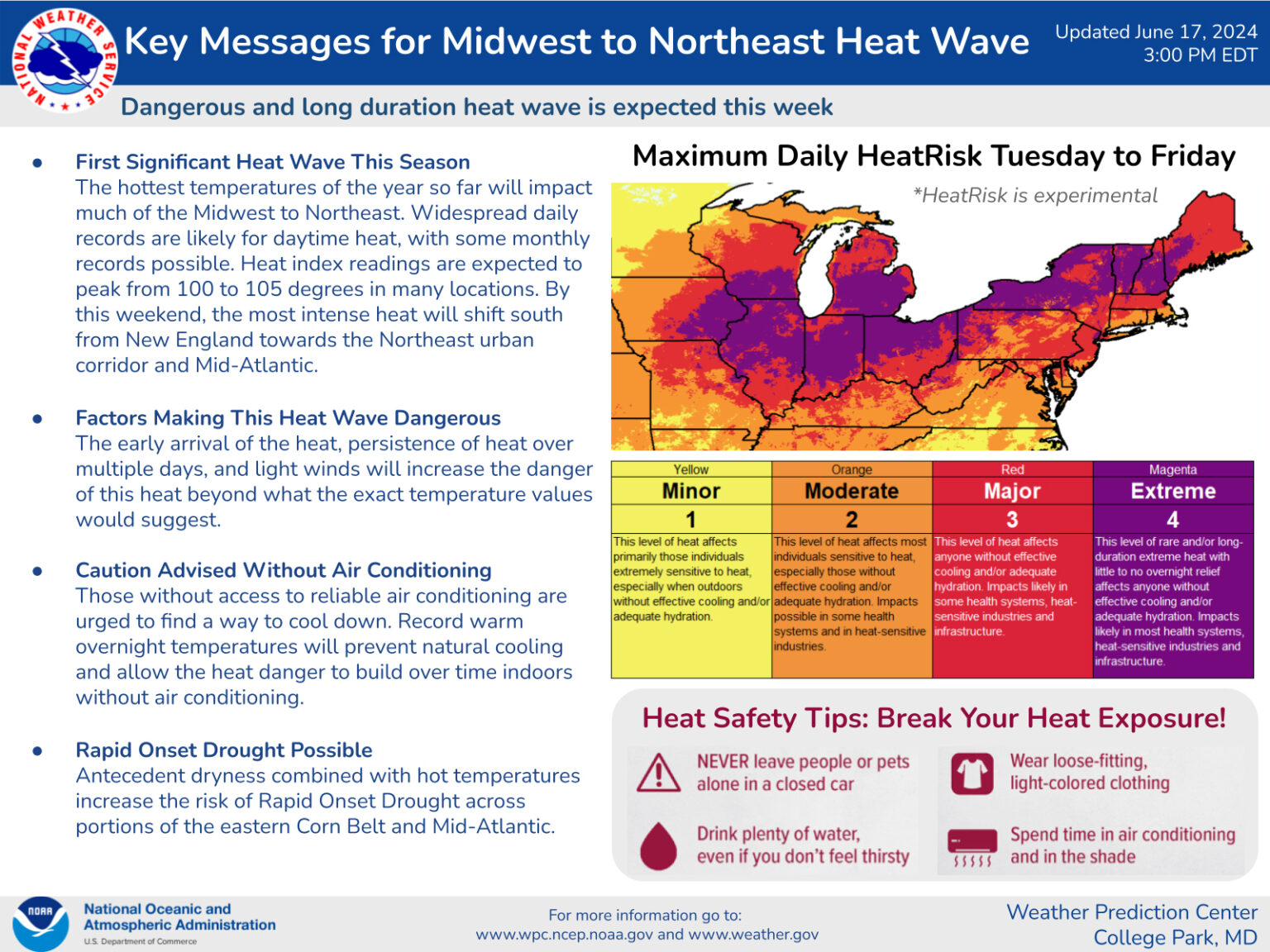As the summer months approach, the United States is bracing for a significant weather event that is poised to have a profound impact on millions of people. A predicted heat dome, a high-pressure system that traps hot air, is set to engulf the northeastern region of the country, sending temperatures soaring to unprecedented levels.

According to meteorologists, the heat dome is expected to bring temperatures up to 41°C (105°F) to the affected areas, potentially impacting over 260 million people across the country. This prolonged period of extreme heat is not only a concern for public health but also poses a threat to the environment, infrastructure, and the economy.
What is a Heat Dome?
Understanding the Heat Dome Phenomenon
A heat dome is a high-pressure system that traps hot air, causing temperatures to rise significantly above average for an extended period. This weather pattern is characterized by a dome-like structure of warm, high-pressure air that sits over a region, preventing the escape of heat and leading to a prolonged heatwave.
Characteristics of a Heat Dome
The key characteristics of a heat dome include:
- Persistent high-pressure system: The high-pressure system at the center of the heat dome acts as a barrier, preventing the normal flow of air and trapping the hot air beneath it.
- Sinking air: The sinking air within the high-pressure system compresses and warms, further intensifying the heat.
- Lack of cloud cover: The stable air under the heat dome inhibits cloud formation, allowing more of the sun’s radiation to reach the Earth’s surface and contribute to the overall heating effect.
The Science Behind the Heat Dome
The formation of a heat dome is a complex interplay of atmospheric conditions and global weather patterns. Factors such as the position of high-pressure systems, the movement of jet streams, and the influence of climate change can all contribute to the development of a heat dome.

As the Earth’s temperature continues to rise due to climate change, the frequency and intensity of heat domes are expected to increase, posing a growing threat to communities across the United States.
Impacts of the Heat Dome Over The US
Risks to Public Health
The soaring temperatures associated with the heat dome can have severe consequences for public health, particularly for vulnerable populations such as the elderly, young children, and those with underlying medical conditions. Heat-related illnesses, including heat exhaustion and heatstroke, can lead to hospitalization and even fatalities if left untreated.
| Potential Health Impacts | Description |
|---|---|
| Heat-related Illnesses | Conditions such as heat exhaustion, heatstroke, and heat cramps can become life-threatening if not properly managed. |
| Exacerbation of Chronic Conditions | Individuals with heart disease, respiratory issues, or other pre-existing medical conditions may experience worsening symptoms during a heatwave. |
| Increased Mortality Rates | Extreme heat can directly lead to an increase in heat-related deaths, particularly among the elderly and those with underlying health problems. |
Strain on Infrastructure and Utilities
The extreme heat generated by the heat dome can also put a significant strain on critical infrastructure and utilities, such as:
- Electricity grids: Increased demand for air conditioning and cooling can overwhelm power systems, leading to potential blackouts.
- Transportation: Roads, bridges, and railways may experience damage or disruption due to heat-induced expansion and softening of materials.
- Water supply: High temperatures can lead to increased water usage and potential shortages, especially in drought-prone regions.
Environmental Impacts
The prolonged heatwave associated with the heat dome can have far-reaching consequences for the environment, including:
- Increased risk of wildfires: Dry and hot conditions can heighten the risk of wildfires, which can threaten communities and ecosystems.
- Reduced agricultural yields: Extreme heat can stress crops and livestock, leading to decreased agricultural productivity and potential food shortages.
- Strain on water resources: The combination of high temperatures and increased water usage can deplete water supplies, exacerbating droughts and affecting aquatic ecosystems.
Economic Implications
The impacts of the heat dome can also have significant economic consequences, including:
- Increased energy costs: The high demand for air conditioning and cooling can lead to spikes in energy prices and utility bills.
- Disruptions to business operations: Extreme heat can force businesses to temporarily close or reduce their operations, leading to lost productivity and revenue.
- Strain on healthcare systems: The influx of heat-related illnesses can overwhelm healthcare facilities and increase medical costs.
Preparedness and Mitigation Strategies
Individual Preparedness
To protect themselves and their families during the upcoming heat dome, individuals can take the following steps:
- Stay hydrated: Drink plenty of water and avoid sugary or alcoholic beverages, which can contribute to dehydration.
- Seek cooling centers: Utilize public spaces, such as libraries, community centers, or malls, that provide air conditioning and respite from the heat.
- Limit outdoor activities: Avoid unnecessary outdoor exposure during the hottest hours of the day, especially for vulnerable populations.
- Wear lightweight, light-colored clothing: This can help regulate body temperature and reduce the risk of heat-related illnesses.
Community-level Mitigation Strategies
Local governments and communities can implement various strategies to mitigate the impact of the heat dome, including:
- Establishing cooling centers: Provide accessible, air-conditioned spaces for residents to seek refuge during periods of extreme heat.
- Implementing heat emergency plans: Develop and activate comprehensive plans to coordinate response efforts and assist vulnerable populations.
- Promoting energy efficiency: Encourage the use of energy-efficient building materials, appliances, and cooling systems to reduce the strain on power grids.
- Enhancing urban green spaces: Increase the presence of trees, parks, and green infrastructure to help mitigate the urban heat island effect.
Long-term Adaptation Measures
In the face of a changing climate and the increasing frequency of extreme heat events, long-term adaptation strategies are essential to build resilience and better prepare communities for the future. These measures may include:
- Investing in infrastructure upgrades: Strengthening power grids, transportation networks, and water systems to withstand the impacts of extreme heat.
- Implementing heat-resilient building codes: Updating building standards to incorporate passive cooling techniques and heat-resistant materials.
- Expanding public health programs: Enhancing early warning systems, public education campaigns, and targeted support for vulnerable populations.
- Promoting sustainable urban planning: Integrating heat-mitigating design elements, such as green roofs and cool pavements, into urban development.
Government Response and Resources
Federal and State Agencies
In response to the impending heat dome, various federal and state agencies have mobilized resources and initiatives to support affected communities. Key agencies involved include the National Weather Service, the Federal Emergency Management Agency (FEMA), the Centers for Disease Control and Prevention (CDC), and state and local emergency management offices.
These agencies provide a range of resources, including:
- Real-time weather updates and heat advisories
- Guidance on heat-related illness prevention and response
- Coordinating emergency response efforts and distributing aid
- Funding for infrastructure upgrades and community resilience projects
Community Support Services
In addition to government resources, communities can also leverage local support services and organizations to provide assistance during the heat dome event. These may include:
- Cooling centers and shelters
- Meal delivery programs for vulnerable populations
- Transportation assistance for those unable to access cooling centers
- Volunteer networks to check on elderly and isolated individuals
By working together and utilizing the available resources, communities can better prepare for and respond to the challenges posed by the impending heat dome.
Conclusion
As the heat dome approaches, it is clear that millions of people across the United States are at risk of facing the severe consequences of this extreme weather event. The prolonged period of soaring temperatures has the potential to strain critical infrastructure, compromise public health, and have far-reaching environmental and economic impacts.
However, with proactive planning, community-level coordination, and individual preparedness, it is possible to mitigate the risks and protect vulnerable populations. By staying informed, taking immediate action, and investing in long-term adaptation strategies, we can work together to ensure the safety and well-being of our communities during this challenging time.
The upcoming heat dome serves as a stark reminder of the urgent need to address the underlying issues of climate change and build resilience against the growing threat of extreme weather events. By prioritizing preparedness, strengthening our infrastructure, and fostering collaborative solutions, we can better safeguard our communities and ensure a more sustainable future for all.





